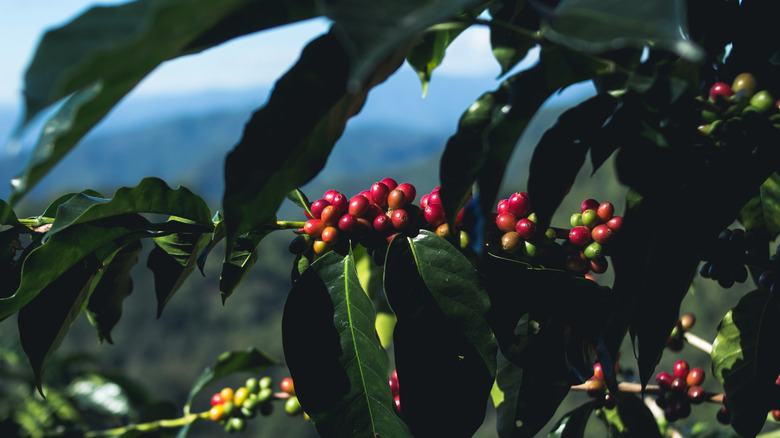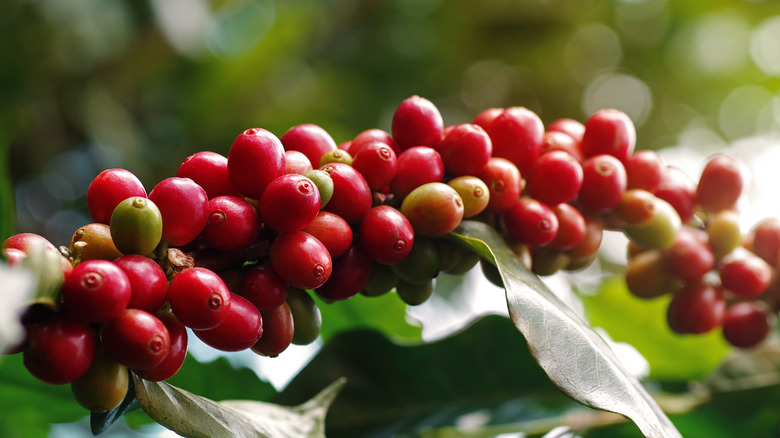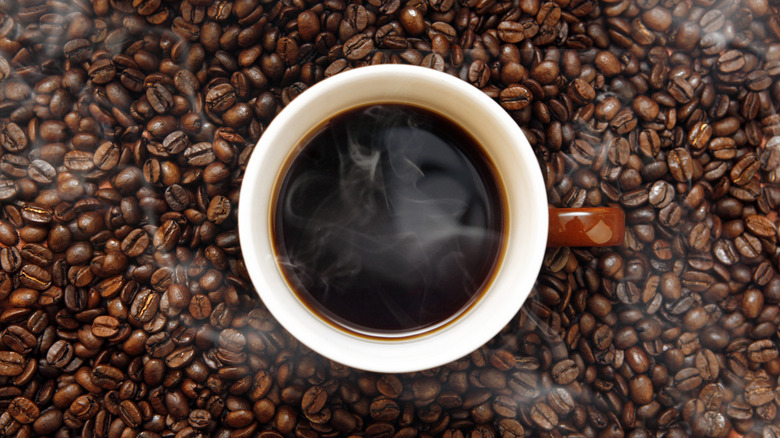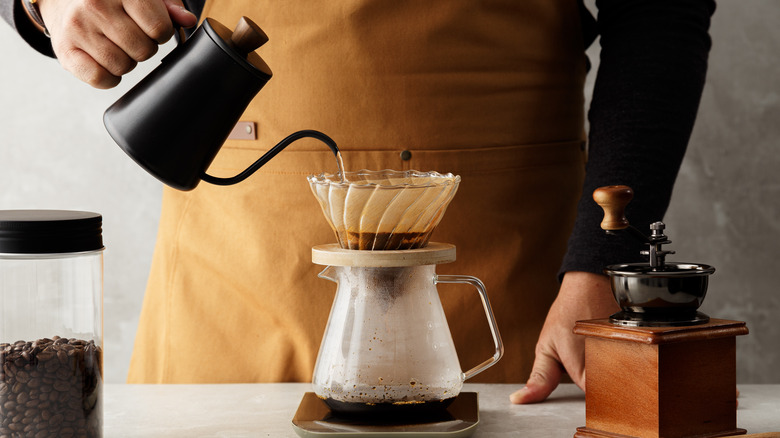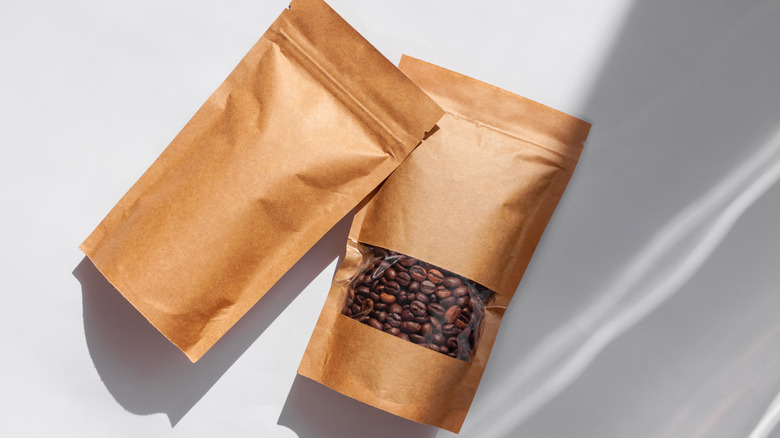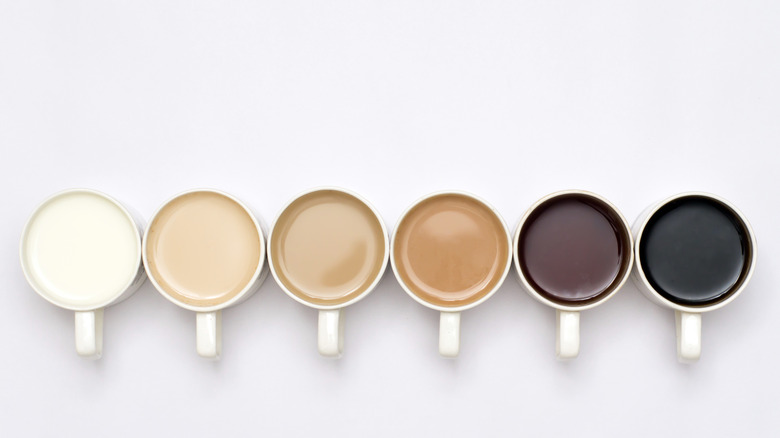What Are Shade-Grown Coffee Beans And Are They Sustainable?
Globally, the coffee industry has been in a bit of a pickle. Rising temperatures are fuelling droughts, floods, and rust outbreaks all around the world, particularly in Latin America, a region that is home to the crop's top producers. Experts estimate that, by 2050, as much as half of the planet's coffee-producing land will be unusable. But as the coffee agriculture business looks for ways to adapt, it's also being forced to look at its own contributions to the climate crisis.
Not only does the industry partake in the collective burning of nearly 200,000 acres of rainforest each day for agricultural and industrial use, but it is also guilty of mono-cropping: an agricultural practice that plants the same crop year after year. Without rotating the crops, the soil isn't able to restore nutrients, leaving it dry, depleted, and virtually worthless for production — often leading to even more problems. With their soil depleted, farmers become dependent on the use of pesticide sprays. According to Ohio State University's Environmental Science Bites, the chemicals only further erode the soil and contribute to more pollution.
That's why, as conversations open up about the global food system and its environmental impact, more people are paying attention to where their coffee comes from and how it's made. In fact, some are opting for an entirely different coffee plant entirely — and no, it's not the bean-free kind. It's the shade-grown kind.
How are shade-grown coffee beans made?
As it turns out, there are two different types of coffee plants: the type that grows in the sun and the type that grows in the shade. But, unlike sun-growing coffee beans, the shade-grown kind requires no clear-cutting of trees or burning rainforests. It's quite the opposite situation, actually. Shade-grown coffee beans rely on the sun protection the trees offer and, in most cases, are planted among them. The practice is known as agroforestry, and it has a lot of benefits for the environment and your coffee.
You can think of agroforestry as the opposite of mono-cropping. Compared to planting fields of the same crop season after season on one plot of land, agroforestry mixes wood plants with agriculture. Not only are the added trees and biodiversity great for the environment, but in the case of shade-grown coffee, they contribute to the overall quality of your brew. That's because the shade from the trees acts as protection for the plants by defending them from the hot sun, reducing the need for pesticides, and maintaining a consistent temperature.
In turn, shade-grown coffee beans mature much slower than sun-grown ones, but the resulting coffee requires much fewer chemicals with even more flavor.
What does shade-grown coffee taste like?
When it comes to differentiating the taste of shade-grown and sun-grown coffee, things can get pretty complicated. That's because, similar to wine grapes, the flavor of coffee beans is indicative of the plant's terroir, meaning there's a whole list of natural environmental factors that tell of its taste — not just how much sun it got. That being said, the running argument seems to be that growing coffee plants under a canopy of trees, as any other under-story shrub of its kind would grow naturally, stimulates characteristics that are reflected in the quality of the cup.
It has also been said that, by slowing down the maturation of the cherries, coffee beans that were grown in the shade can develop higher levels of natural sugars that actually lower the coffee's acidity and enhance its flavor. This makes sense, seeing as some of the most loved coffee varieties in the world happen to be shade-grown. However, how much the shade affects it is totally dependent on what other natural environmental factors are present, including topography, temperature, rainfall, and soil. So, to get a high-quality, shade-grown brew, the other factors of its terroir must also meet the plant's standards.
Preparing shade-grown coffee
While their agricultural processes may be completely opposite, shade-grown coffee and sun-grown coffee are both coffee at the end of the day, providing that fresh, hot mug we all so desperately look forward to in the mornings. The good news is, should you switch over to a shade-grown bag or pod, you won't have to change anything about your morning coffee routine. Whether you prefer a french press, pour-over, automatic drip, or your trusty Keurig — with shade-grown coffee, it's all the same.
As with any coffee, shade-grown beans should be stored someplace cool and dry to keep the flavors and aromas at their best. If you buy your beans whole, grinding is an essential step that you'll want to get right. Conical burr grinders are often preferred to blade grinders among coffee connoisseurs, as they tend to do a better job at preserving the coffee's delicate flavors. You'll also want to be careful not to over-grind, which often leads to bitterness. After that, you can proceed with your coffee as you normally would.
If you can get those two steps right, your shade-grown brew should come out just as good as whatever you drank before — if not better.
Where to buy shade-grown coffee
Fortunately, as sustainability has become more and more prevalent among grocery shoppers, buying shade-grown coffee is just as easy as shopping for any other type of coffee. Just look for bags from brands labeled as "shade grown" on their packaging or websites. Words like "bird friendly," and "organic" are also often indicators of coffee that has been shade grown.
You'll find bags of shade-grown beans in the aisle of almost any shopping store, in light, medium, and dark roasts, from many different parts of the world. In fact, you can use the country of origin as an indicator as to whether or not the coffee has been shade grown. Coffee from southern Mexico, El Salvador, Peru, Panama, Nicaragua, and Guatemala is more often shade-grown than coffees from Colombia, Brazil, or Costa Rica, but there are always exceptions.
If you're not having any luck finding shade-grown coffees locally, you can also look online. Coffee brands like Life Boost and Pachamama offer shade-grown blends and beans, but you can also find shade-grown coffee from brands like Tomorrow's Coffee on Amazon.
Nutritional information for shade-grown coffee
When comparing the nutritional benefits between shade-grown coffee and sun-grown, there isn't much of a difference — they are both coffee, after all. Shade-grown beans offer much of the same health benefits you typically get from any other cup of coffee: antioxidants, B vitamins, potassium, riboflavin, and, of course, energizing caffeine (per Cleveland Clinic). Just like with sun-grown coffee, drinking moderate amounts of it may lower your risk for several chronic diseases, including Alzheimer's, diabetes, Parkinson's, liver and colorectal cancer, and depression. But that doesn't mean you should drink too much of it.
Coffee is one of the most popular beverages on the planet – more than two billion cups of it are drank around the world every single day (via British Coffee Association). That being said, you don't want to go overboard on your coffee consumption. Whether sun-grown or shade-grown, coffee on its own can have a positive effect on your health, but it is often served with added ingredients like sugar, whipped cream, and flavored syrups that aren't necessarily nutritious. You'll especially want to keep that in mind if you drink multiple cups daily. Experts recommend three to four cups a day max, and sticking to low-fat milk and natural sweeteners like date syrup, if you add anything.
Coffee isn't necessarily for everyone — even if it is healthy. While moderate coffee consumption won't dehydrate you, excessive amounts will. Some people may also experience anxiety or elevated blood pressure symptoms if they drink too much.
